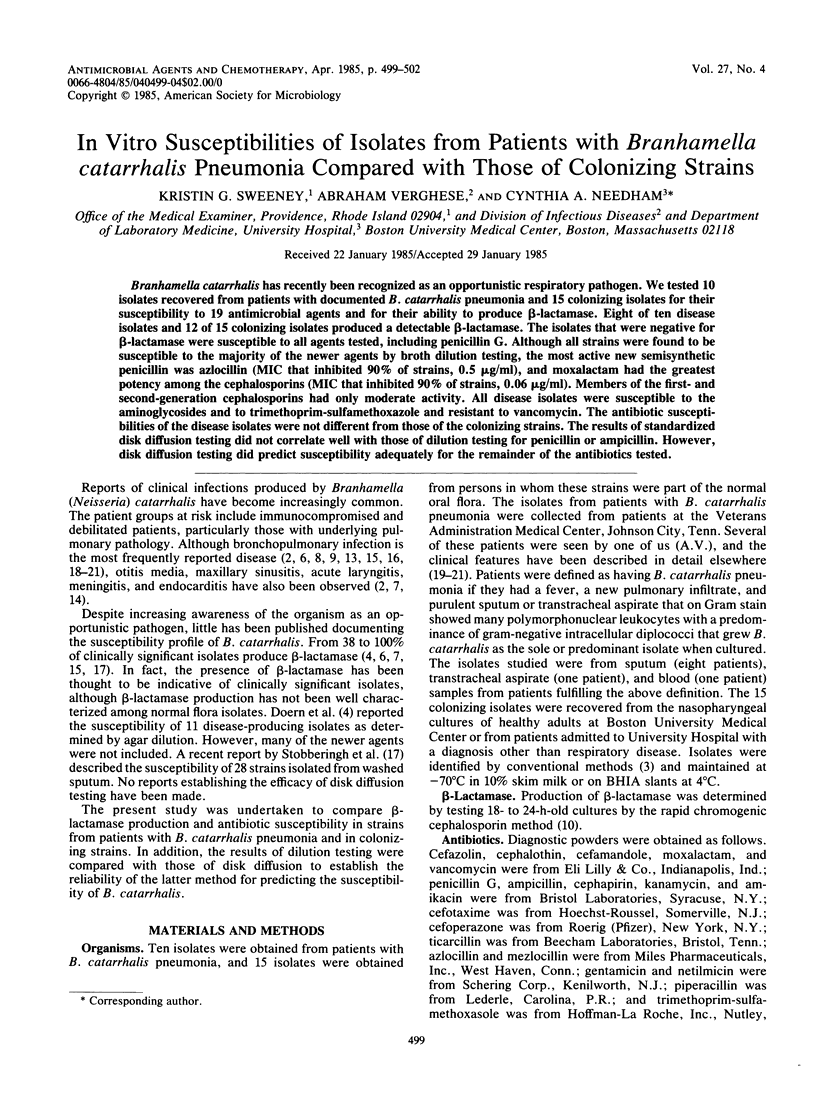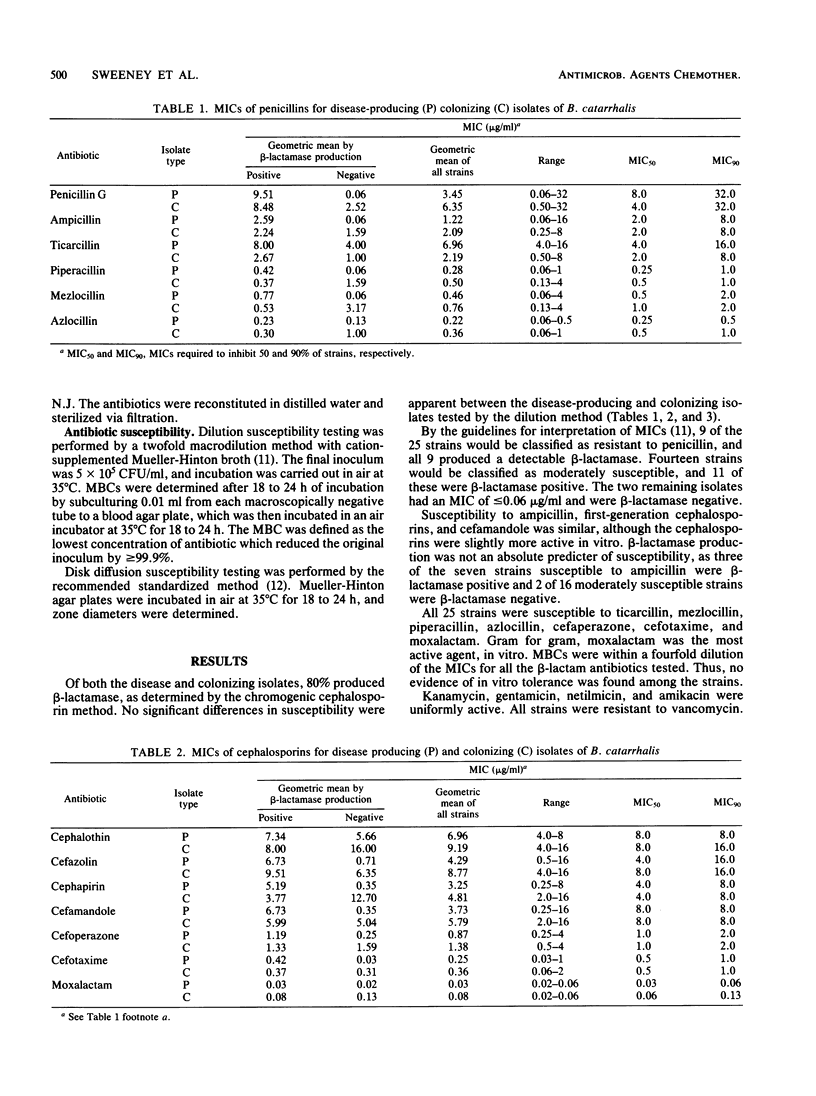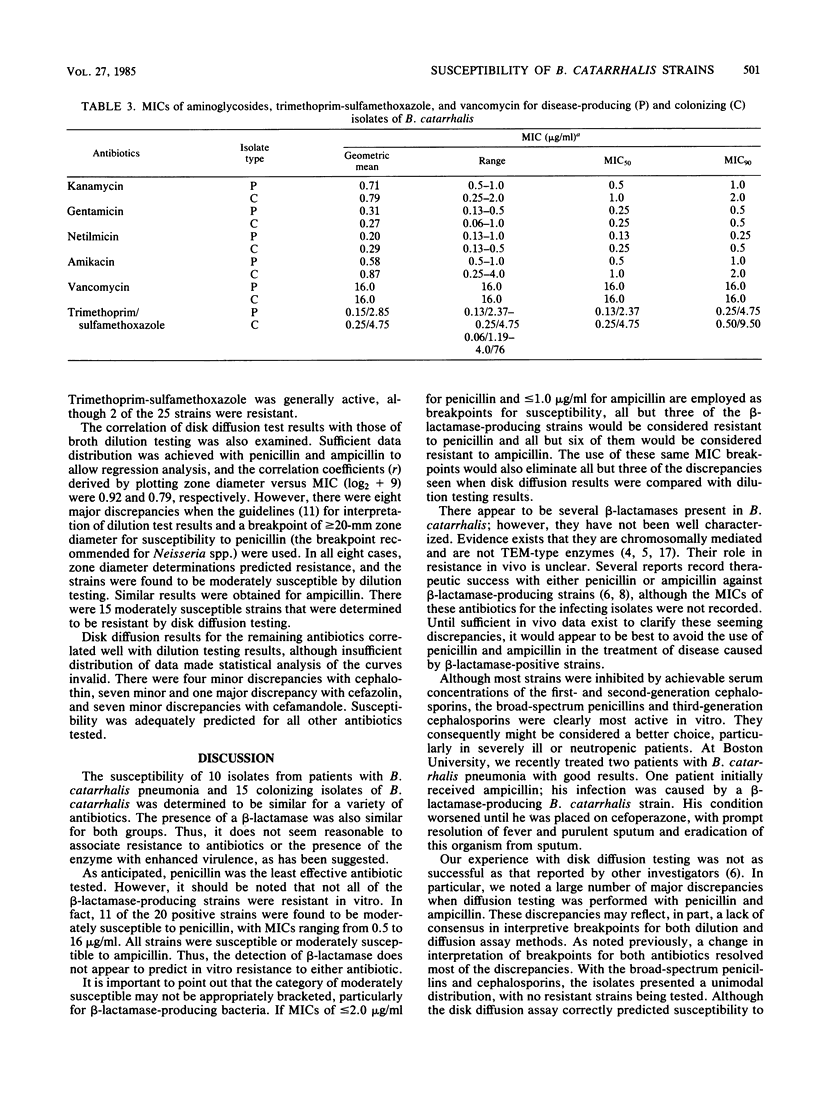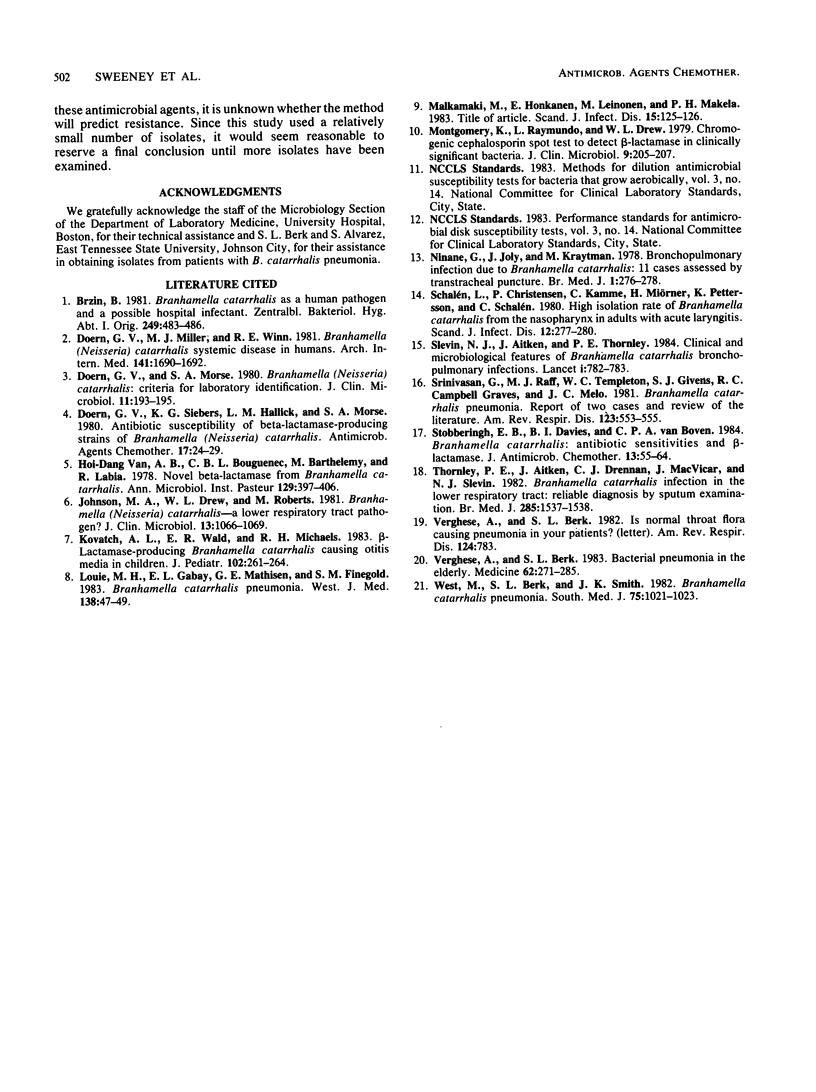Abstract
Branhamella catarrhalis has recently been recognized as an opportunistic respiratory pathogen. We tested 10 isolates recovered from patients with documented B. catarrhalis pneumonia and 15 colonizing isolates for their susceptibility to 19 antimicrobial agents and for their ability to produce beta-lactamase. Eight of ten disease isolates and 12 of 15 colonizing isolates produced a detectable beta-lactamase. The isolates that were negative for beta-lactamase were susceptible to all agents tested, including penicillin G. Although all strains were found to be susceptible to the majority of the newer agents by broth dilution testing, the most active new semisynthetic penicillin was azlocillin (MIC that inhibited 90% of strains, 0.5 micrograms/ml), and moxalactam had the greatest potency among the cephalosporins (MIC that inhibited 90% of strains, 0.06 micrograms/ml). Members of the first- and second-generation cephalosporins had only moderate activity. All disease isolates were susceptible to the aminoglycosides and to trimethoprim-sulfamethoxazole and resistant to vancomycin. The antibiotic susceptibilities of the disease isolates were not different from those of the colonizing strains. The results of standardized disk diffusion testing did not correlate well with those of dilution testing for penicillin or ampicillin. However, disk diffusion testing did predict susceptibility adequately for the remainder of the antibiotics tested.
Full text
PDF



Selected References
These references are in PubMed. This may not be the complete list of references from this article.
- Brzin B. Branhamella catarrhalis as a human pathogen and a possible hospital infectant. Zentralbl Bakteriol Mikrobiol Hyg A. 1981;249(4):483–486. [PubMed] [Google Scholar]
- Doern G. V., Miller M. J., Winn R. E. Branhamella (Neisseria) catarrhalis systemic disease in humans. Case reports and review of the literature. Arch Intern Med. 1981 Nov;141(12):1690–1692. [PubMed] [Google Scholar]
- Doern G. V., Morse S. A. Branhamella (Neisseria) catarrhalis: criteria for laboratory identification. J Clin Microbiol. 1980 Feb;11(2):193–195. doi: 10.1128/jcm.11.2.193-195.1980. [DOI] [PMC free article] [PubMed] [Google Scholar]
- Doern G. V., Siebers K. G., Hallick L. M., Morse S. A. Antibiotic susceptibility of beta-lactamase-producing strains of Branhamella (Neisseria) catarrhalis. Antimicrob Agents Chemother. 1980 Jan;17(1):24–29. doi: 10.1128/aac.17.1.24. [DOI] [PMC free article] [PubMed] [Google Scholar]
- Hoi-Dang A. B., Brive-Le Bouguenec C., Barthelemy M., Labia R. Novel beta-lactamase from Branhamella catarrhalis. Ann Microbiol (Paris) 1978 Oct;129 B(3):397–406. [PubMed] [Google Scholar]
- Johnson M. A., Drew W. L., Roberts M. Branhamella (Neisseria) catarrhalis--a lower respiratory tract pathogen? J Clin Microbiol. 1981 Jun;13(6):1066–1069. doi: 10.1128/jcm.13.6.1066-1069.1981. [DOI] [PMC free article] [PubMed] [Google Scholar]
- Kovatch A. L., Wald E. R., Michaels R. H. beta-Lactamase-producing Branhamella catarrhalis causing otitis media in children. J Pediatr. 1983 Feb;102(2):261–264. doi: 10.1016/s0022-3476(83)80537-x. [DOI] [PubMed] [Google Scholar]
- Louie M. H., Gabay E. L., Mathisen G. E., Finegold S. M. Branhamella catarrhalis pneumonia. West J Med. 1983 Jan;138(1):47–49. [PMC free article] [PubMed] [Google Scholar]
- Malkamäki M., Honkanen E., Leinonen M., Mäkelä P. H. Branhamella catarrhalis as a cause of bacteremic pneumonia. Scand J Infect Dis. 1983;15(1):125–126. doi: 10.3109/inf.1983.15.issue-1.21. [DOI] [PubMed] [Google Scholar]
- Montgomery K., Raymundo L., Jr, Drew W. L. Chromogenic cephalosporin spot test to detect beta-lactamase in clinically significant bacteria. J Clin Microbiol. 1979 Feb;9(2):205–207. doi: 10.1128/jcm.9.2.205-207.1979. [DOI] [PMC free article] [PubMed] [Google Scholar]
- Ninane G., Joly J., Kraytman M. Bronchopulmonary infection due to Branhamella catarrhalis: 11 cases assessed by transtracheal puncture. Br Med J. 1978 Feb 4;1(6108):276–278. doi: 10.1136/bmj.1.6108.276. [DOI] [PMC free article] [PubMed] [Google Scholar]
- Schalén L., Christensen P., Kamme C., Miörner H., Pettersson K. I., Schalén C. High isolation rate of Branhamella catarrhalis from the nasopharynx in adults with acute laryngitis. Scand J Infect Dis. 1980;12(4):277–280. doi: 10.3109/inf.1980.12.issue-4.07. [DOI] [PubMed] [Google Scholar]
- Slevin N. J., Aitken J., Thornley P. E. Clinical and microbiological features of Branhamella catarrhalis bronchopulmonary infections. Lancet. 1984 Apr 7;1(8380):782–783. doi: 10.1016/s0140-6736(84)91288-1. [DOI] [PubMed] [Google Scholar]
- Srinivasan G., Raff M. J., Templeton W. C., Givens S. J., Graves R. C., Melo J. C. Branhamella catarrhalis pneumonia: report of two cases and review of the literature. Am Rev Respir Dis. 1981 May;123(5):553–555. doi: 10.1164/arrd.1981.123.5.553. [DOI] [PubMed] [Google Scholar]
- Stobberingh E. E., Davies B. I., van Boven C. P. Branhamella catarrhalis: antibiotic sensitivities and beta-lactamases. J Antimicrob Chemother. 1984 Jan;13(1):55–64. doi: 10.1093/jac/13.1.55. [DOI] [PubMed] [Google Scholar]
- Thornley P. E., Aitken J., Drennan C. J., MacVicar J., Slevin N. J. Branhamella catarrhalis infection of the lower respiratory tract: reliable diagnosis by sputum examination. Br Med J (Clin Res Ed) 1982 Nov 27;285(6354):1537–1538. doi: 10.1136/bmj.285.6354.1537. [DOI] [PMC free article] [PubMed] [Google Scholar]
- Verghese A., Berk S. L. Bacterial pneumonia in the elderly. Medicine (Baltimore) 1983 Sep;62(5):271–285. doi: 10.1097/00005792-198309000-00002. [DOI] [PubMed] [Google Scholar]
- Verghese A., Berk S. L. Is normal throat flora causing pneumonia in your patients? Am Rev Respir Dis. 1982 Jun;125(6):783–784. doi: 10.1164/arrd.1982.125.6.783. [DOI] [PubMed] [Google Scholar]
- West M., Berk S. L., Smith J. K. Branhamella catarrhalis pneumonia. South Med J. 1982 Aug;75(8):1021–1023. doi: 10.1097/00007611-198208000-00029. [DOI] [PubMed] [Google Scholar]


